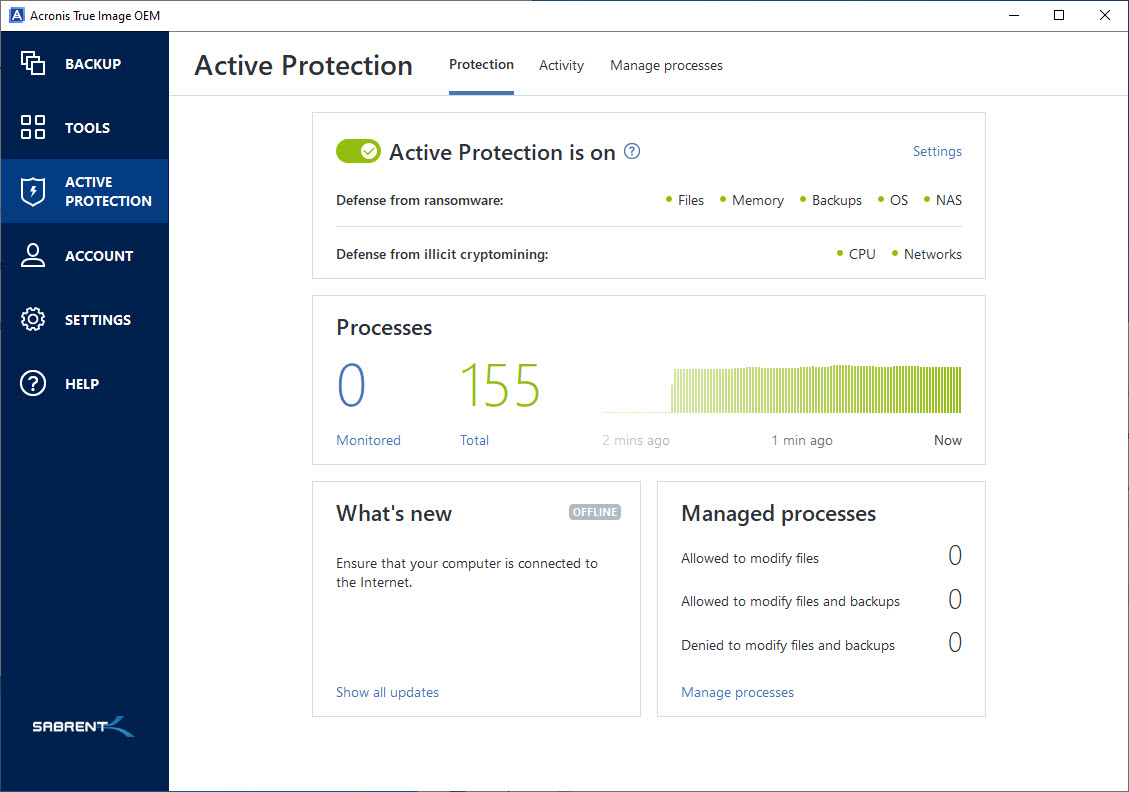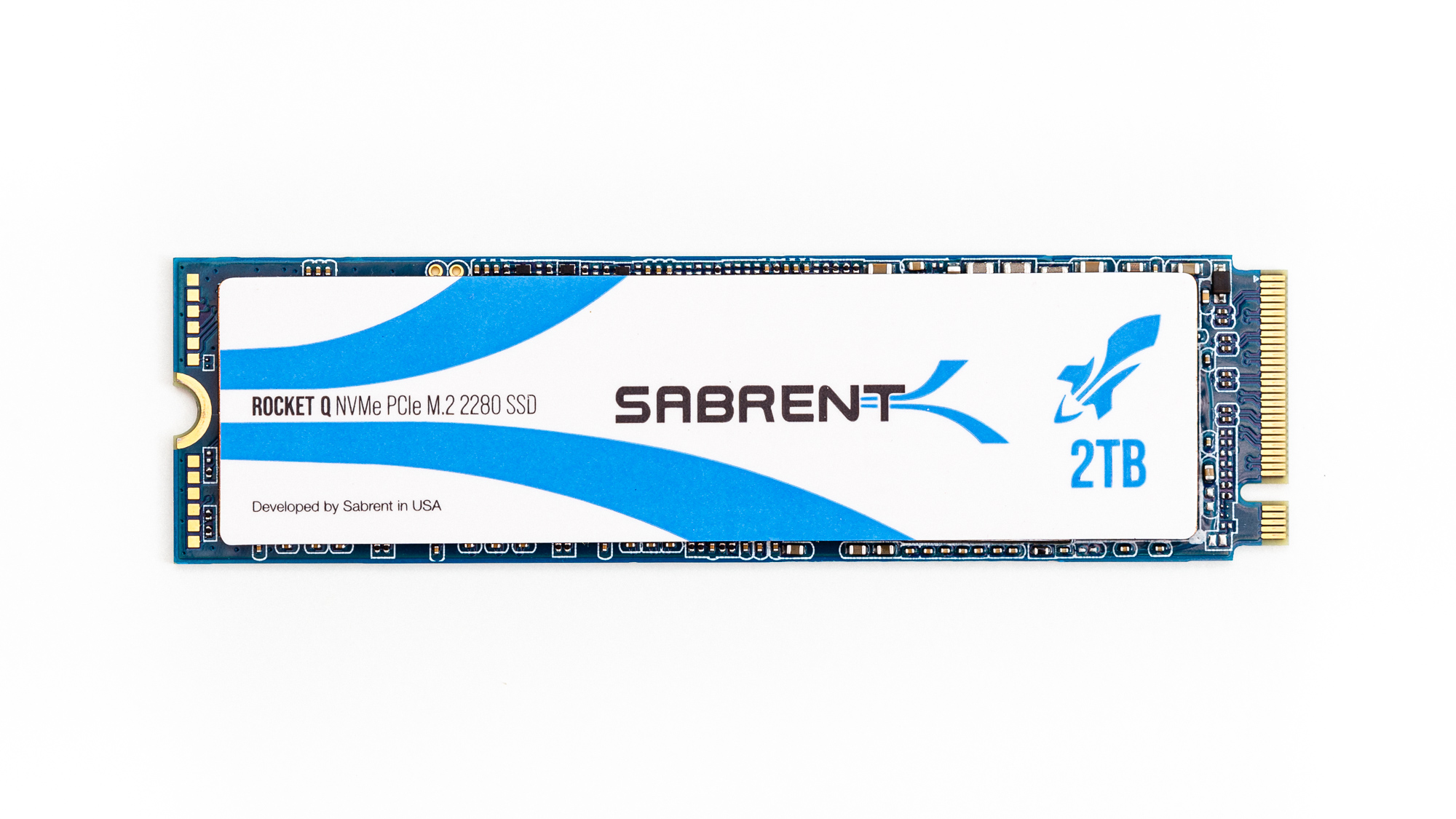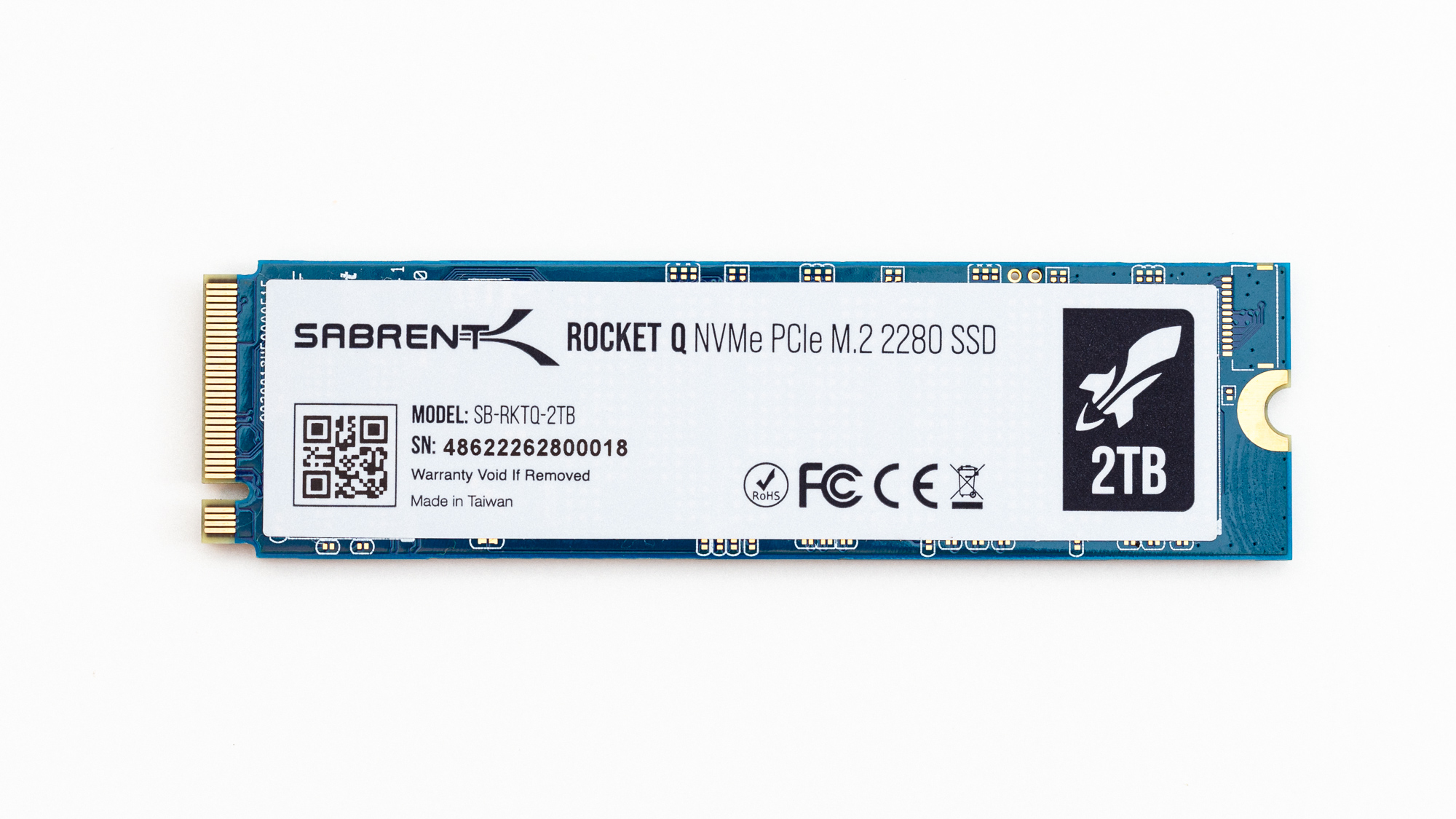Tom's Hardware Verdict
Weighing in as the industry’s highest-capacity M.2 NVMe SSD, Sabrent’s 8TB Rocket Q is a pint-sized monster best suited for the data hoarder on the go.
Pros
- +
Highest-capacity M.2 SSD available
- +
Competitive performance and efficiency
- +
Software support
- +
Aesthetics
- +
Up to five-year warranty
Cons
- -
Expensive
- -
One-year warranty w/out registration
- -
Slow write speed after write cache fills
- -
Low endurance-per-GB compared to TLC
- -
May throttle without cooling
Why you can trust Tom's Hardware
Sabrent's new Rocket Q series offers a great mix of value and performance, but it also offers a big first: The first 8TB SSD for us normal folks in the M.2 form factor. That massive capacity will slot right into a notebook for those on the go, or you can just slap one into your desktop PC and never worry about the size of your game folder again. Well, you won't have to worry for at least a few years.
That massive slab of storage capacity comes with a big price tag, though, with the 8TB Sabrent Rocket Q weighing in at a hefty $1,500. You get some of the best performance we've seen from a QLC SSD in exchange, so splurging on Sabrent's 8TB SSD is worth it if you're after the highest capacity possible. Sabrent also serves up high-performance and high-capacity SSDs for enthusiasts with any need, too, so we also have the 2TB Rocket Q model in for review today.
Up until recently, your only option to go beyond 2TB was to get a 2.5” SATA SSD, like the Samsung 860 series or WD Blue 3D, but those drives are limited to about 4TB and are slower than NVMe SSDs.
QLC SSDs bring higher capacities at a lower price-per-GB than TLC SSDs, but manufacturers haven’t put much effort into bringing higher-capacity M.2 NVMe drives to the consumer market. This is tied into the choice of matching lower-performing, lower-endurance QLC flash with inexpensive four-channel NVMe controllers. Until now, no company tried pushing the performance boundaries with QLC NAND by pairing it with an 8-channel NVMe controller, so we didn't have an option for both high-performance and high-capacity QLC M.2 NVMe SSDs.
With a high-performance Phison E12S NVMe controller and Micron’s Latest 96L QLC NAND flash, not only does Sabrent’s Rocket Q come in capacities that double and even quadruple the Intel, Samsung, WD, and Crucial drives, it has the performance to keep up with the best of them, too.
Specifications
| Product | Rocket Q 500GB | Rocket Q 1TB | Rocket Q 2TB | Rocket Q 4TB | Rocket Q 8TB |
|---|---|---|---|---|---|
| Pricing | $69.99 | $129.99 | $239.99 | $719.99 | $1,499.99 |
| Capacity (User / Raw) | 500GB / 512GB | 1000GB / 1024GB | 2000GB / 2048GB | 4000GB / 4096GB | 8000GB / 8192GB |
| Form Factor | M.2 2280 | M.2 2280 | M.2 2280 | M.2 2280 | M.2 2280 |
| Interface / Protocol | PCIe 3.0 x4 / NVMe 1.3 | PCIe 3.0 x4 / NVMe 1.3 | PCIe 3.0 x4 / NVMe 1.3 | PCIe 3.0 x4 / NVMe 1.3 | PCIe 3.0 x4 / NVMe 1.3 |
| Controller | Phison E12S | Phison E12S | Phison E12S | Phison E12S | Phison E12S |
| DRAM | DDR3L | DDR3L | DDR3L | DDR3L | DDR3L |
| Memory | Micron 96L QLC | Micron 96L QLC | Micron 96L QLC | Micron 96L QLC | Micron 96L QLC |
| Sequential Read | 2,000 MBps | 3,200 MBps | 3,200 MBps | 3,200 MBps | 3,300 MBps |
| Sequential Write | 1,000 MBps | 2,000 MBps | 3,000 MBps | 3,000 MBps | 2,900 MBps |
| Random Read | 95,000 IOPS | 125,000 IOPS | 255,000 IOPS | 550,000 IOPS | 550,000 IOPS |
| Random Write | 250,000 IOPS | 500,000 IOPS | 670,000 IOPS | 680,000 IOPS | 680,000 IOPS |
| Endurance (TBW) | 120 TB | 260 TB | 530 TB | 940 TB | 1,800 TB |
| Part Number | SB-RKTQ-500 | SB-RKTQ-1TB | SB-RKTQ-2TB | SB-RKTQ-4TB | SB-RKTQ-8TB |
| Warranty | 5-Years w/ registration; 1-Year w/out | 5-Years w/ registration; 1-Year w/out | 5-Years w/ registration; 1-Year w/out | 5-Years w/ registration; 1-Year w/out | 5-Years w/ registration; 1-Year w/out |
Features
Sabrent’s Rocket Q comes in capacities as low as 500GB and span up to a massive 8TB. The pricing on most capacities is affordable compared to many TLC and DRAMless SSDs, although the larger capacities are a bit pricey. The sample we're reviewing today comes in at a moderate 2TB capacity and features one of the lowest price-per-GB ratios at its $239.99 price point.
Sabrent’s Rocket Q’s performance places it well above its QLC SSD competition. Sabrent rates the Rocket Q at up to 3.2/3.0 GBps of sequential read/write throughput, but write performance is dependent on its dynamic write cache. About one-quarter of available capacity is set aside as cache space, but beyond that, write performance will degrade to much slower levels. We'll measure that impact on the next page. When taxed with random workloads, the Rocket Q is rated to deliver up to 550,000 / 680,000 read/write IOPS.
Get Tom's Hardware's best news and in-depth reviews, straight to your inbox.
The device supports Trim, secure erase, and S.M.A.R.T. data reporting like most SSDs. It also has multiple power states to help save power in mobile devices.
Although the Rocket Q uses Low-Density Parity-Check (LDPC) ECC to help ensure data integrity over time, its endurance ratings are low compared to TLC SSDs. In general, it offers about one-half to one-third of the endurance per capacity point. If you opt for the big bad 8TB model, you can still get very good endurance coverage during the five-year warranty, though. But that's only if you register for it: Sabrent’s Rocket Q comes with a one-year warranty that only transitions to a five-year warranty if you register your device within 90 days.
Software and Accessories




The SSD comes bare of any accessories, but the company includes plenty of software support. Downloads include Sabrent’s Sector Size Converter (SSC) in case you need to change between 4Kn and 512e sector formats, a Control Panel app to monitor the device and update the firmware, and a free-to-use copy of Acronis True Image OEM for drive cloning and backup.
A Closer Look





Sabrent's Rocket Q is a PCIe 3.0 x4 NVMe SSD that comes in an M.2 2280 single-sided form factor, which is especially impressive for a 2TB drive. While we typically dislike the blue PCBs some SSDs have, such as the Rocket Q, not many companies try to tie the color into the aesthetic like Sabrent's design does. Sabrent even left the ugly barcode and compliance stickers on the backside of the device. Kudos to Sabrent for the attention to detail.
Like the Sabrent Rocket NVMe 4.0, the Rocket Q has a copper label on top of the components to aid with cooling. The SSD uses a Phison E12S NVMe controller, which is the latest variant of the popular Phison E12. It packs a lot of performance while taking up a smaller footprint on the PCB, enabling the single-sided form factor at this capacity. The newer controller is built on a 12nm manufacturing process node, which helps to tame power and temperatures. The dual Cortex R5 CPUs and dual co-processors (CoXProcessor 2.0 technology) operate at the same 666MHz frequency.
For the 2TB model, four NAND packages with four high-density 1Tb Micron 96L QLC NAND flash dies interface with the controller over eight flash channels at 666 MT/s. The SSD has 16 dies total, thus populating about half of E12S's chip enables. The 8TB drive features 64 1Tb dies, which is two dies per chip enable.
This NAND's operating speed is a nice little bump up compared to the Phison E12 and lower density BiCS3 64L TLC NAND based SSDs we have reviewed in the past that operate at 533 MT/s. About 9% of the Rocket Q's raw space is used as overprovisioned space for garbage collection and other background activities, too.
The 2TB SSD has a 512MB NANYA DDR3L 1600MHz DRAM chip for FTL table buffering. The typical DRAM:NAND ratio is 1MB:1GB, so the company must use FTL table compression and/or prioritize hot and cold metadata.

Sean is a Contributing Editor at Tom’s Hardware US, covering storage hardware.
-
MartinBarcelona Good news, 1/4 of the drive being slc (to use as cache) is alot.. so best drive .. for such capacity..Reply
Sabrent’s Rocket Q features a massive dynamic SLC write cache that spans a quarter of the SSD’s available capacity. The 8TB Rocket Q wrote a little over 2.1TB of data at 2.9 GBps before degrading to an average speed of 276 MBps after the write cache filled. -
gio2vanni86 Saw linus put this thing through a test. Seems fast. And the storage is heading into the right direction. The only problem i see is the same one i saw back in 2010... $$$$. Thats a steep price to swallow.Reply -
geogan Considering how much disc recovery firms charge to attempt to recover data from failed normal SATA drives... I'd love to see how much they would charge to try and recover all 8TB of your data when this fails... if you have something like this you 100% also need to budget another couple hundred for a 10TB backup SATA drive.Reply
I have seen ridiculous prices from some of these recovery companies like charging 500 straight up then and more to pay for the clone drive plus something like $75 for each TB over 1TB to recover. I calculated the cost of restoring a bog standard 6TB WD drive at over $1000 which for a drive that cost me $150 second hand is just <Mod Edit> ridiculous. They are gougers, talking advantage of people being desperate to recover their precious recordings/pictures/data. Don't give them the chance. -
mik1 Tomshardware, I can't find any latency measurements per read operation out there! As in you give the SSD a 4K aligned read command, how many milliseconds will it take for it to respond.Reply
I believe it is ballpark 0.5 milliseconds which is the typical for most recent M.2 NVMe SSDs currently (and Optane leads with 0.01), can you please confirm? -
seanwebster Reply
Double check the iometer /synthetic testing section of the benchmark pages, it should be there.mik1 said:Tomshardware, I can't find any latency measurements per read operation out there! As in you give the SSD a 4K aligned read command, how many milliseconds will it take for it to respond.
I believe it is ballpark 0.5 milliseconds which is the typical for most recent M.2 NVMe SSDs currently (and Optane leads with 0.01), can you please confirm? -
mik1 @seanwebster I reviewed page 2 and 3 carefully now and there are now IO latency numbers there.Reply
If there would have been any screenshots of IOMeter, I presume they would have shown the latency, but none are published. -
seanwebster Reply
I don’t take screenshots of the iometer results, I log them and sort through the raw data to chart it instead.mik1 said:@seanwebster I reviewed page 2 and 3 carefully now and there are now IO latency numbers there.
If there would have been any screenshots of IOMeter, I presume they would have shown the latency, but none are published. -
mik1 @seanwebster i don't see any latency chart, did you provide one?Reply
(I only see the "tracing testing", maybe that depends on latency and so reflects it, i'd greatly appreciate an actual latency metric though) -
seanwebster Replymik1 said:@seanwebster i don't see any latency chart, did you provide one?
(I only see the "tracing testing", maybe that depends on latency and so reflects it, i'd greatly appreciate an actual latency metric though)
It isn't under trace testing, it is under "synthetic testing - iometer," as mentioned previously. You need to look through the gallery for the 4K random QD1 response latency. Sequential read is only the first image of the iometer gallery.
I've attached the 8TB results from the review.